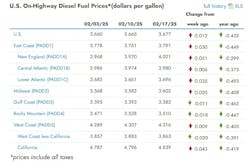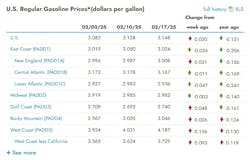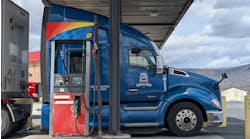Diesel prices in most of the U.S. crept up this week as the national average rose to $3.677. This increase of slightly more than 1 cent mirrors last week’s increase as the trend continues.
According to the U.S. Energy Information Administration's February 17 report, most of the U.S. saw diesel pump prices increase from 1 to 5 cents. The most significant increase was in New England, up 5 cents to $4.021. The East Coast as a whole rose by 3 cents to $3.791. The West Coast experienced the smallest increase for 1 cent to a whopping $4.316. The Midwest increased 2 cents to a comparatively smaller price of $3.602.
The two regions that experienced price decreases were the Gulf Coast and Rocky Mountains. The decreases were relatively smaller at 1 cent to $3.382 and 2 cents to $3.510, respectively. Without factoring in California, the West Coast experienced a diesel price decrease by 2 cents to $3.863, a significant price difference.
But if you were to consult the AAA motor club instead of EIA, the outlook is ever-so-slightly more optimistic. According to AAA, the average U.S. diesel price this week is $3.675, 0.2 cents lower than EIA’s tracking and 0.7 cents higher than AAA’s average from last week. This is still significantly lower than last year's average of $4.106.
See also: 2025 FleetOwner 500: For-Hire sees significant carrier shifts
Gas prices continue upward trend
Motorists won’t see a break in the form of gas price decreases for their pickups and sedans either. The national average gas price has risen to $3.148, according to EIA. This is up 2 cents from last week as gasoline prices only climb higher.
The East Coast and the Midwest were the only areas to see decreases in gas prices. The East Coast average fell by 3 cents to $3.024, and the Midwest went down by less than 1 cent to $2.982.
Unsurprisingly, the most significant gas price increase was seen on the West Coast, as prices rose by 15 cents to $4.187. If you remove California, the West Coast average price increase would still be a considerable 10 cents. The Gulf Coast and Rocky Mountain area saw considerably smaller increases. The Gulf Coast average rose by 5 cents to $2.740, and the Rocky Mountain average rose by 3 cents to $3.046.
Instead of raising our spirits, the AAA average gas price forecast is more bleak. Their average gas price of $3.161 is 0.13 cents higher than the EIA's average of $3.148. Also, AAA reports an increase of 2 cents over last week's predicted average of $3.141. But the silver lining is that gas prices, according to AAA, are still lower than the average from a year ago: $3.279.






